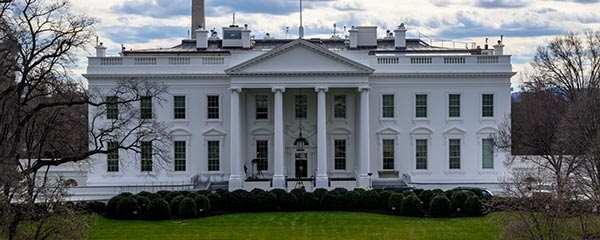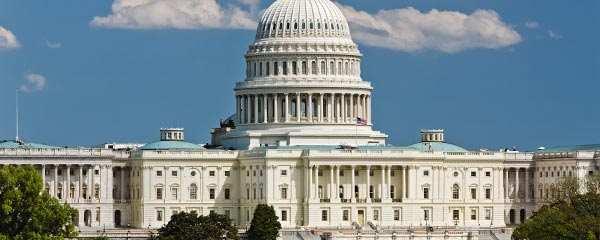Story Highlights
- 82% of Americans say cyberterrorism is a "critical threat"
- Development of nuclear weapons in North Korea (77%), Iran (75%) rank next
- Partisans differ most on threat level of illegal immigrants, climate change
WASHINGTON, D.C. -- As the Biden administration continues to explore how it will respond to Russia's large-scale cyberattack against U.S. companies and federal agencies last year, 82% of Americans say cyberterrorism is a "critical threat" to the vital interests of the U.S. over the next decade.
While cyberterrorism ranks atop a list of 11 potential threats to the U.S., the development of nuclear weapons by North Korea and by Iran are not far behind, with 77% and 75% of U.S. adults, respectively, considering them to be critical threats. Four other matters are likewise viewed as critical threats by majorities in the U.S.: international terrorism (72%), the spread of infectious diseases throughout the world (72%), China's economic power (63%), and global warming or climate change (58%).
Forty-six percent of Americans view large numbers of immigrants trying to enter the U.S. as a critical threat to the country, although that measure was taken before the recent influx of immigrants, including many unaccompanied minors, attempting to enter the U.S at the southern border.
| Critical threat | Important, not critical | Not important | |||||||||||||||||||||||||||||||||||||||||||||||||||||||||||||||||||||||||||||||||||||||||||||||||
|---|---|---|---|---|---|---|---|---|---|---|---|---|---|---|---|---|---|---|---|---|---|---|---|---|---|---|---|---|---|---|---|---|---|---|---|---|---|---|---|---|---|---|---|---|---|---|---|---|---|---|---|---|---|---|---|---|---|---|---|---|---|---|---|---|---|---|---|---|---|---|---|---|---|---|---|---|---|---|---|---|---|---|---|---|---|---|---|---|---|---|---|---|---|---|---|---|---|---|---|
| % | % | % | |||||||||||||||||||||||||||||||||||||||||||||||||||||||||||||||||||||||||||||||||||||||||||||||||
| Cyberterrorism, the use of computers to cause disruption or fear in society | 82 | 16 | 2 | ||||||||||||||||||||||||||||||||||||||||||||||||||||||||||||||||||||||||||||||||||||||||||||||||
| Development of nuclear weapons by North Korea | 77 | 21 | 2 | ||||||||||||||||||||||||||||||||||||||||||||||||||||||||||||||||||||||||||||||||||||||||||||||||
| Development of nuclear weapons by Iran | 75 | 21 | 3 | ||||||||||||||||||||||||||||||||||||||||||||||||||||||||||||||||||||||||||||||||||||||||||||||||
| International terrorism | 72 | 24 | 4 | ||||||||||||||||||||||||||||||||||||||||||||||||||||||||||||||||||||||||||||||||||||||||||||||||
| The spread of infectious diseases throughout the world | 72 | 26 | 3 | ||||||||||||||||||||||||||||||||||||||||||||||||||||||||||||||||||||||||||||||||||||||||||||||||
| The economic power of China | 63 | 30 | 7 | ||||||||||||||||||||||||||||||||||||||||||||||||||||||||||||||||||||||||||||||||||||||||||||||||
| Global warming or climate change | 58 | 23 | 19 | ||||||||||||||||||||||||||||||||||||||||||||||||||||||||||||||||||||||||||||||||||||||||||||||||
| Large numbers of immigrants entering the U.S. illegally | 46 | 35 | 19 | ||||||||||||||||||||||||||||||||||||||||||||||||||||||||||||||||||||||||||||||||||||||||||||||||
| The military power of Russia | 44 | 46 | 9 | ||||||||||||||||||||||||||||||||||||||||||||||||||||||||||||||||||||||||||||||||||||||||||||||||
| The conflict between the Israelis and the Palestinians | 32 | 54 | 12 | ||||||||||||||||||||||||||||||||||||||||||||||||||||||||||||||||||||||||||||||||||||||||||||||||
| The conflict between China and Taiwan | 30 | 53 | 16 | ||||||||||||||||||||||||||||||||||||||||||||||||||||||||||||||||||||||||||||||||||||||||||||||||
| Â鶹´«Ã½AV, Feb. 3-18, 2021 | |||||||||||||||||||||||||||||||||||||||||||||||||||||||||||||||||||||||||||||||||||||||||||||||||||
These findings are from Â鶹´«Ã½AV's annual World Affairs survey, which was conducted Feb. 3-18, after President Joe Biden spoke with Russian President Vladimir Putin and made it clear "that the United States will act firmly in defense of its national interests in response to actions by Russia that harm us or our allies."
While the Biden administration has not yet taken any overt action to address the development of North Korea's nuclear weapons, it has been highly focused on Iran. The survey's field period ended just as the Biden administration attempted to begin talks to revive the Iran nuclear deal. The following week, in his first military action as president, Biden ordered airstrikes in Syria targeting Iran-backed militias, after a U.S. service member and coalition troops were wounded in a rocket attack. Biden said the retaliatory airstrikes were intended to make it clear that while the U.S. was interested in pursuing a nuclear deal with Iran, it would not allow the country to "act with impunity."
Â鶹´«Ã½AV first gauged the public's views of various potential threats to the U.S. in 2004 and then periodically between 2010 and 2019. For the most part, current assessments of threat levels are mostly unchanged compared with readings from the past few years. However, several of this year's findings are particularly notable:
-
The 63% of Americans who say China's economic power is a critical threat marks a new high and an increase from 46% in 2019. This comes as Americans now perceive China as the greatest enemy of the U.S.
-
After hitting a high point in 2019, assessments of Russia's military power have moderated, with 44% now saying it is a critical threat and 46% important but not critical. In 2019, 52% characterized it as a critical and 39% an important threat.
-
Americans' perceived threat level for the spread of infectious diseases throughout the world, at 72%, is nine percentage points higher than the prior reading, in 2016, reflecting the effect of the global coronavirus pandemic that continues to ravage the world.
Partisans' Perceptions of Potential Threats
Majorities across party lines agree that six of the 11 potential threats are critical to the United States' interests. Roughly equal percentages of Republicans and Republican-leaning independents, as well as Democrats and Democratic-leaning independents, think three of them are critical threats: cyberterrorism, the development of nuclear weapons by North Korea and international terrorism.
Meanwhile, although majorities agree each is critical, partisans view the other three threats differently. Republicans are more likely than Democrats to think the development of nuclear weapons by Iran and the economic power of China are critical threats. The opposite is true of the global spread of infectious diseases. These differences are largely rooted in the stances of Donald Trump when he was president. Trump withdrew the U.S. from the Iran nuclear deal and reinstated sanctions against the country, raised tariffs and imposed sanctions on China, and downplayed the danger of the coronavirus.
Although fewer than half of each party group agree that Russia's military power, the conflict between China and Taiwan, and the Israeli-Palestinian conflict are critical threats, their views differ somewhat. Democrats are more likely than Republicans to think Russia's military power is a critical threat, while the opposite is true of the conflict between China and Taiwan. Views of the threat level of the Israeli-Palestinian conflict are similar by party.
Partisans have sharply different views of the threat levels of two other issues: illegal immigration and global warming. Republicans are more than three times as likely as Democrats to say large numbers of immigrants entering the U.S. illegally is a critical threat. At the same time, Democrats are more than three times as likely as Republicans to consider climate change or global warming to be a critical threat.
| Republicans/ Leaners |
Democrats/ Leaners |
Gap between Republicans and Democrats |
||||||||||||||||||||||||||||||||||||||||||||||||||||||||||||||||||||||||||||||||||||||||||||||||||
|---|---|---|---|---|---|---|---|---|---|---|---|---|---|---|---|---|---|---|---|---|---|---|---|---|---|---|---|---|---|---|---|---|---|---|---|---|---|---|---|---|---|---|---|---|---|---|---|---|---|---|---|---|---|---|---|---|---|---|---|---|---|---|---|---|---|---|---|---|---|---|---|---|---|---|---|---|---|---|---|---|---|---|---|---|---|---|---|---|---|---|---|---|---|---|---|---|---|---|---|---|
| % | % | pct. pts. | ||||||||||||||||||||||||||||||||||||||||||||||||||||||||||||||||||||||||||||||||||||||||||||||||||
| Majorities in each party | ||||||||||||||||||||||||||||||||||||||||||||||||||||||||||||||||||||||||||||||||||||||||||||||||||||
| Economic power of China | 78 | 52 | +26 | |||||||||||||||||||||||||||||||||||||||||||||||||||||||||||||||||||||||||||||||||||||||||||||||||
| Iran's development of nuclear weapons | 83 | 68 | +15 | |||||||||||||||||||||||||||||||||||||||||||||||||||||||||||||||||||||||||||||||||||||||||||||||||
| N. Korea's development of nuclear weapons | 77 | 76 | +1 | |||||||||||||||||||||||||||||||||||||||||||||||||||||||||||||||||||||||||||||||||||||||||||||||||
| International terrorism | 72 | 72 | 0 | |||||||||||||||||||||||||||||||||||||||||||||||||||||||||||||||||||||||||||||||||||||||||||||||||
| Cyberterrorism | 81 | 82 | -1 | |||||||||||||||||||||||||||||||||||||||||||||||||||||||||||||||||||||||||||||||||||||||||||||||||
| Spread of infectious diseases in the world | 61 | 82 | -21 | |||||||||||||||||||||||||||||||||||||||||||||||||||||||||||||||||||||||||||||||||||||||||||||||||
| Democratic majority only | ||||||||||||||||||||||||||||||||||||||||||||||||||||||||||||||||||||||||||||||||||||||||||||||||||||
| Global warming or climate change | 27 | 86 | -59 | |||||||||||||||||||||||||||||||||||||||||||||||||||||||||||||||||||||||||||||||||||||||||||||||||
| Republican majority only | ||||||||||||||||||||||||||||||||||||||||||||||||||||||||||||||||||||||||||||||||||||||||||||||||||||
| Large numbers of immigrants illegally entering U.S. | 75 | 20 | +55 | |||||||||||||||||||||||||||||||||||||||||||||||||||||||||||||||||||||||||||||||||||||||||||||||||
| Less than majorities in each party | ||||||||||||||||||||||||||||||||||||||||||||||||||||||||||||||||||||||||||||||||||||||||||||||||||||
| Conflict between China and Taiwan | 36 | 23 | +13 | |||||||||||||||||||||||||||||||||||||||||||||||||||||||||||||||||||||||||||||||||||||||||||||||||
| Conflict between Israelis and Palestinians | 35 | 30 | +5 | |||||||||||||||||||||||||||||||||||||||||||||||||||||||||||||||||||||||||||||||||||||||||||||||||
| Military power of Russia | 39 | 49 | -10 | |||||||||||||||||||||||||||||||||||||||||||||||||||||||||||||||||||||||||||||||||||||||||||||||||
| GALLUP, Feb. 3-18, 2021 | ||||||||||||||||||||||||||||||||||||||||||||||||||||||||||||||||||||||||||||||||||||||||||||||||||||
Bottom Line
The events of the past two years have affected Americans' perceptions regarding the type of threat that a number of issues and situations pose to the vital interests of the U.S. Recent hacks by Russia and China have kept cyberterrorism atop the list of 11 potential threats, and continued tensions with North Korea and Iran over their nuclear weapons aspirations have kept these among the top perceived threats. The coronavirus pandemic has heightened the view that the spread of infectious diseases worldwide is critical. With Biden bringing a new perspective to many issues, this could influence Americans' future views of threat levels.
View complete question responses and trends (PDF download).
Learn more about how the works.




